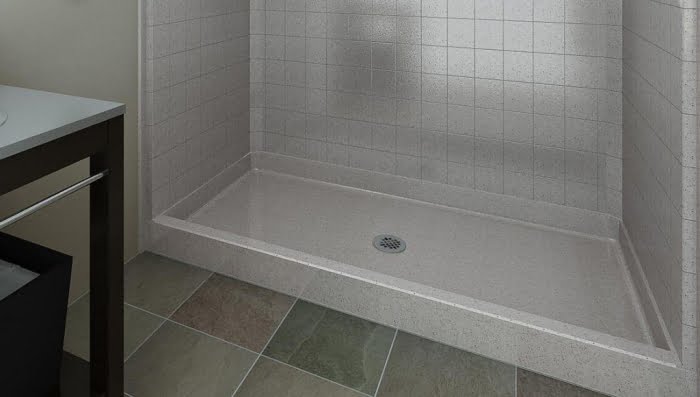A leaking shower pan can go unnoticed for long periods, often resulting in extensive and costly water damage. For homeowners, detecting and addressing a shower pan leaking promptly is crucial to mitigate damage not only to the bathroom but potentially to other structures of the home. In states where humidity and frequent usage can exacerbate these issues, understanding the legal landscape – with the help of our water damage insurance attorneys – around insurance claims for such damages is vital.
At The Morgan Law Group, our insurance claims attorneys share a few tips on how to proactively identify a potential shower pan leaking, so you can mitigate the damages and the repair expenses that result.
What Is a Shower Pan?
A shower pan, also called a shower base, is simply the floor of your shower.
The low-walled pan is available in acrylic, ceramic, porcelain, plastic, fiberglass, custom tile, and composite materials, and is available in nearly endless sizes.
The pans are covered with a waterproof liner to protect the surrounding areas – and underlying structures – from damage.
Shower pans are designed to collect all the water from your shower head and move it down the drain.
Can Shower Pan Leaks Cause Significant Water Damage?
A shower pan leaking can be more than a minor drip. In some cases, the water seeps below the tile into subflooring or moves into adjacent walls. This can jeopardize the structural stability of the shower itself, as well as nearby building materials. Once moisture infiltrates wood, sheetrock, or insulation, it can weaken these materials and allow decay to spread.
- Potential for Extensive Rot: Shower pans are typically installed with a slope designed to direct water toward the drain. However, if the slope is compromised or if there are cracks or breaks in the seal around the pan, water may accumulate where it should not. That moisture can rot subfloors and framing components, especially if left unaddressed for an extended period.
- Secondary Damage to Personal Property: A shower pan leaking can also affect belongings stored in the area underneath a bathroom or along shared walls, causing stains or moisture damage to furniture, rugs, or personal items. Property owners often notice these issues too late, when visible signs of leaks appear on ceilings, walls, or floors below.
- Mold Growth: Leaks that persist are susceptible to mold, which can be very difficult to remove. Once a mold colony develops, it may compromise air quality. Insurers frequently require evidence that homeowners took swift action to mitigate the water source before mold developed. Failing to address a leak can lead to coverage disputes, especially if the mold infestation is deemed a result of negligence.
Causes and Repairs for Shower Pan Leakage
A shower pan leak may manifest subtly – tiles may start to feel loose or spongy, or you might notice mold growth along the baseboards or the corners of the shower. At times, you may even see water stains on the ceilings of rooms located directly below a bathroom. Such indications suggest a leaking shower pan, which, if ignored, can lead to significant structural damage over time.
The causes of shower pan failure range from poor installation to natural degradation of materials. Over time, the sealing and grout may fail, or the shower pan itself might crack, leading to leakage.
Immediate steps to take include assessing the extent of the leak and consulting with professionals about shower pan leaking repair. Often, the solution may involve resealing the shower pan or entirely replacing the faulty installation.
Most Common Causes of Shower Pan Leaks
Shower pan leaking can be caused by several different factors that are not always obvious.
That can include:
- Normal Wear and Tear: Although shower pans are designed to last a long time, their function can make them vulnerable to daily wear and tear from people entering and exiting the shower, and the constant influx of water. It can take years, possibly even decades, for a properly installed shower pan to become damaged by normal wear and tear, but it is not impossible.
- Movement: A properly installed shower pan should not move in any direction during use. However, if it is not properly affixed using bolts, sealants, and caulk, it can move and begin cracking, which will allow water to seep through to the floor and into the area or room below it.
- Deflection and/or Poor Drainage: The shower pan has a specific gradient meant to direct the water to the drain. Poor drainage can cause water to accumulate on the surrounding floor between the drain and the shower pan.
Most Common Signs of a Shower Pan Leak
A shower pan leak does not always announce itself with puddles on the bathroom floor. Often, the early signs appear in adjacent or lower levels of the property. Checking areas around your shower from time to time may help you catch a possible leak before it causes widespread damage.
Common signs of shower pan leaks can include:
- Loose floor tiles adjacent to the shower: When water seeps beneath tiles and lingers, the bond between the tile and adhesive can weaken. If the floor around a shower appears uneven or some tiles have started to loosen or pop up, a leaking shower pan could be the culprit.
- Soggy carpet area by a shared wall: Nearby carpeted areas may become damp or show discoloration where water has traveled beyond the bathroom.
- Water stains on the ceiling of the area/room below where your shower sits: If the bathroom is on an upper level, watch for visible stains or water rings on the ceiling directly beneath the shower. This is one of the most recognizable signals that water has escaped the shower assembly and is settling in the ceiling material.
- Water-stained baseboards nearby: In some cases, a shower pan leaking may cause discoloration on baseboards or walls in adjacent rooms. The closer these signs are to the shower, the more likely the source is a defective or aging shower pan.
Staying vigilant can help property owners detect problems before moisture spreads. Water damage insurance claims are frequently filed when a hidden leak emerges in a big way. Quick detection can help you preserve important evidence of loss if you need to pursue coverage under your policy.
How Can I Test For a Shower Pan Leaking?
Perform a simple test at home to determine whether water is escaping from the shower pan. Early detection is key to preventing substantial damage.
- Gather Your Supplies: Prepare a bucket, duct tape, and set aside at least eight hours to monitor for leaks. Be sure to fill the bucket from a different faucet or tub spout – avoiding the showerhead helps isolate the shower pan as the potential source of any leaks.
- Seal the Drain: Use duct tape to cover the drain. This keeps water inside the pan area and prevents it from flowing out prematurely. The floor of your shower should be completely dry before you add water for the test.
- Fill With Water: Pour water from the bucket into the shower pan until it is about one inch deep. Make note of the water level once you have stopped filling. Check for any immediate signs of water escaping the shower assembly.
- Monitor Over Eight Hours: Observe the surrounding floor, nearby walls, and the ceiling underneath the shower at regular intervals. If the water level drops, or if you see any dripping or staining, there is a strong likelihood of a leak in the shower pan.
- Track Changes: Document any discoveries, whether they are stains, dripping water, or changes in water level. This information may be useful if you decide to consult with a legal professional or file an insurance claim.
Should you notice suspicious changes, it may be time to explore your coverage options. Insurance policies often have strict requirements regarding timely reporting of water damage, so documenting a shower pan leaking can be vital to a successful claim.
How Can I Fix a Shower Pan Leak?
If you have a leaking shower pan, it may be time to call a professional to ensure the repair or replacement is done properly.
Fixing the leak may require removing the tiling on the floor and lower walls of your shower.
You may also need to remove, repair, or replace nearby water-damaged areas including carpet, flooring, baseboards, and/or drywall.
Proper shower pan installation is a skill best left to professionals.
Water Damage Insurance Claims Due to Shower Pan Leaks
In Florida, homeowners facing water damage due to a leaking shower pan have specific rights under property insurance policies. Most home insurance policies cover water damage that is sudden and accidental. However, insurers often deny claims if they believe the damage results from ongoing neglect, such as failing to maintain a waterproof seal in the shower area.
When filing a water damage claim in Florida, it is crucial to document the damage thoroughly and to understand the policy’s specifics regarding water damage. Florida’s insurance law stipulates that insurers must handle claims fairly and promptly.
If your claim is unjustly denied, legal recourse is available. As a homeowner, you can challenge denials through internal appeals with their insurer or, if necessary, through litigation.
Do You Need to File a Water Damage Claim Due to Shower Pan Leaks?
If you suspect a shower pan leaking in your home, taking immediate action to fix the problem is crucial. Contact a professional for shower pan leak repair and consult our experienced water damage insurance attorney if you face challenges with your insurance claim.
The Morgan Law Group is equipped to help homeowners navigate the complexities of insurance claims and ensure they receive fair compensation for all water-related damages, including those caused by a leaking shower pan.
Don’t let a simple leak turn into a larger financial burden, contact us today to schedule your free case evaluation

